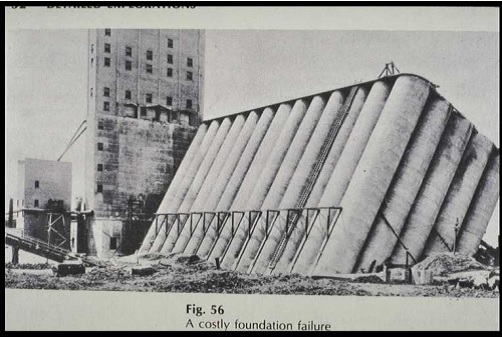Brinch Hansens Method
Courses > Foundation Analysis and Design > Bearing Capacity of Shallow Foundations > Brinch Hansens Method Introduction
Introduction
In geotechnical engineering, bearing capacity is the capacity of soil to support the loads applied to the ground. The bearing capacity of soil is the maximum average contact pressure between the foundation and the soil which should not produce shear failure in the soil. Ultimate bearing capacity (qf) is the theoretical maximum pressure which can be supported without failure; allowable bearing capacity (qa) is the ultimate bearing capacity divided by a factor of safety. Sometimes, on soft soil sites, large settlements may occur under loaded foundations without actual shear failure occurring; in such cases, the allowable bearing capacity is based on the maximum allowable settlement.

A costly foundation failure is shown in the figure above.
» Try our free powerful online bearing capacity calculator «
There are three modes of failure that limit bearing capacity: general shear failure, local shear failure, and punching shear failure.
 Other methods proposed for bearing capacity of shallow foundations are: Terzaghi's bearing capacity method which is the earliest method proposed in 1943, and Meyerhof's method (1951, 1963).
Other methods proposed for bearing capacity of shallow foundations are: Terzaghi's bearing capacity method which is the earliest method proposed in 1943, and Meyerhof's method (1951, 1963).
 Concepts and Formulas
Concepts and Formulas
Brinch Hansen's bearing capacity theory:
Brinch Hansen (1970) provided equations to estimate limit bearing capacity for two separate cases of strength parameters: (1) f> 0, and (2) f= 0 (undrained clay). In addition, for each of these cases there are two separate subcases: (a) Either no horizontal component of load or there is a horizontal component of load and it is in the direction of the width of the footing only; or (b) there is a horizontal component of load in the direction of the length of the footing, or in both directions (width and length of the footing). Equations to estimate limit bearing capacity are provided in the following sections for each of these situations.
In all cases, the limit load that can be carried at the bearing level is given by the following equation
QbL = qbL x Af
 In all equations given below involving B and L, if there is eccentricity at the bearing elevation, use Beff in place of B and Leff in place of L, where Beff= B– 2eB, and Leff= L– 2eL. In the unusual case where L– 2eL< B– 2eB, use Beff= L– 2eL and Leff= B– 2eB
In all equations given below involving B and L, if there is eccentricity at the bearing elevation, use Beff in place of B and Leff in place of L, where Beff= B– 2eB, and Leff= L– 2eL. In the unusual case where L– 2eL< B– 2eB, use Beff= L– 2eL and Leff= B– 2eB
Case 1: f> 0
Subcase a: No Qtr or Qtr,B only
where
q0 = effective stress at the bearing level for an effective stress analysis, and = total stress at the bearing level for a total stress analysis
Nq = eptanf tan2(45+f/2)
Nc = cot f ( Nq – 1)
Ng = (Nq-1) tan (1.4f)
Subcase b: Qtr,L only, or Qtr,B and Qtr,L:
In this case you must check for qbL separately in the directions of the width and length of the footing. Use qbL equal to the smaller of the two values.
Case 2: f= 0
Subcase a: No Qtr or Qtr,B only
where
q0= total stress at the bearing level
where ca = adhesive stress acting on the base of footing, which is usually in the range of (0.5 to 1.0) Su.
For a rough base, use ca=Su.
Subcase b: Qtr,L only, or Qtr,B and Qtr,L:
In this case you must check for qbL separately in the directions of the width and length of the footing. Use qbL equal to the smaller of the two values.
 Watch Videos
Watch Videos
 Solved sample problems
Solved sample problems
 Download Files
Download Files
 Read also
Read also
- Ultimate Tip Resistance of Piles
- Terzaghi's Method
- Meyerhof's Method
- Different Concrete Prestressing Methods
- Free Download Portal Method Analyzer
 Share
Share
Follow our official Facebook page (@civilengineeringbible) and Twitter page (@CivilEngBible) and do not miss the best civil engineering tools and articles!

